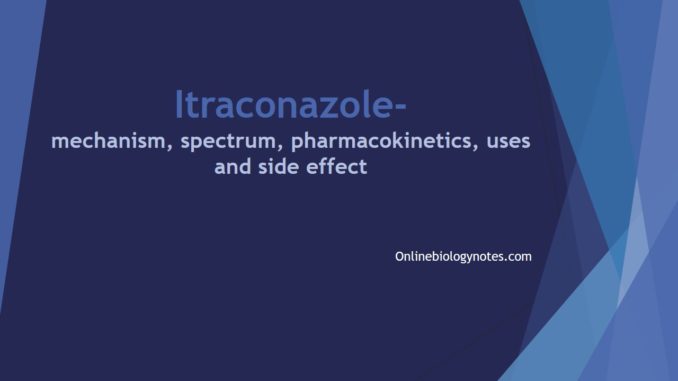
- Itraconazole is one of the antifungal medications used for the treatment of diverse fungal infections.
- It is one of the synthetic dioxolane triazole compounds.
Mechanism of action of Itraconazole:
- It acts like all other azoles i.e. it interferes with the cytochrome P 450-dependent enzyme, lanosterol 14 -demethylase.
- This results in the accumulation of 14-methylsterol and depletion of ergosterol in fungal cells, which ultimately leads to disruptions in membrane structure and function.
Spectrum of action of Itraconazole:
- Itraconazole occupies a broad spectrum of action including Aspergillus species, Blastomyces dermatitidis, Candida species, C. immitis, C. neoformans, Histoplasma capsulatum, Malassezia furfur, Paracoccidioides brasiliensis, P. mameffei, Scedosporium apiospermum and S. schenckii.
- It is less active against Fusarium species.
- It is effective against many dematiaceous moulds and dermatophytes, but doesn’t act against the Zygomycetes.
Acquired Itraconazole resistance:
- Acquired resistance is rare, however, ketoconazole-resistant Candida albicans strains from patients with chronic mucocutaneous candidosis have been cross-resistant to itraconazole.
- Also some fluconazole-resistant C. albicans strains from AIDS patients with chronic relapsing oropharyngeal candidosis show resistance to itraconazole.
- Itraconazole-resistant strains of Aspergillus fumigatus have been reported following treatment, but this is a rare condition.
Pharmacokinetics of Itraconazole:
- The gastrointestinal tract absorption of itraconazole is about 55%, but is enhanced if the drug is taken with food.
- Oral intake of a single 100-mg capsule will result peak serum concentrations of 0.1-0.2 mg/L about 2- 4h later.
- Higher concentrations are achieved, after repeated dosing, however it varies according to individuals.
- Itraconazole has high protein binding capacity, exceeding 99% in human serum.
- Itraconazole has been found to persist in the skin for 2-4 weeks.
- Even after the end of a 4 week course of treatment, it persists in toenails for upto 6 months after the end of a 3-month course of treatment.
Therapeutic use of itraconazole:
- Itraconazole is available in oral and parenteral forms as oral capsules, oral solution and intravenous infusion.
- Itraconazole has been employed to treat several superficial fungal infections, including the dermatophytoses, tinea versicolor, and mucosal and cutaneous forms of candidosis.
- Certain forms of phaeohyphomycosis, and subcutaneous infections such as chromoblastomycosis, sporotrichosis can be treated by itraconazole.
- Itraconazole is drug of choice in case of non-life-threatening forms of blastomycosis and histoplasmosis
- It is a beneficial alternative to amphotericin B for invasive aspergillosis.
- Itraconazole is the drug of choice for maintenance treatment to prevent relapse in AIDS patients with histoplasmosis.
- However, it is less effective than fluconazole as maintenance treatment in AIDS patients with cryptococcosis.
- Itraconazole oral suspension has helped to prevent aspergillosis in neutropenic patients, and has proved an effective treatment for oropharyngeal candidosis in HIV-infected individuals.
- However, the drug has not been adequately evaluated as treatment for deep- seated forms of candidosis.
Side effects of Itraconazole
- The most frequently reported side-effects are gastrointestinal in origin, such as nausea, abdominal discomfort and constipation.
- Less common side-effects include headache, dizziness, pruritus and allergic rashes. Isolated cases of Stevens- Johnson syndrome have been reported.
- The most frequent adverse events among patients treated with intravenous itraconazole have been nausea, diarrhoea and hypokalemia.
- There have been rare cases of liver failure and death among persons taking itraconazole, including some within the first week.
- The drug is best avoided in patients with liver disease and those with elevated liver function tests.
- If signs of liver disease develop during treatment, the drug should be discontinued and liver function tests performed.
- Itraconazole should not be used to treat nail infections in patients who have had heart failure, nor should it be used to treat more serious infections, unless the expected benefit exceeds the risk.
- If signs of congestive heart failure should appear during treatment, itraconazole should be discontinued.
Drug interactions of itraconazole:
- Itraconazole should not be administered together with drugs that reduce gastric acid secretion, such as antacids, H2-antagonists, omeprazole and lansoprazole.
- These drugs reduce absorption of itraconazole.
- Both itraconazole and its major metabolite, hydroxy- itraconazole, are inhibitors of the human hepatic cytochrome P-450-3A4 enzyme system.
- Associated administration of itraconazole with other drugs that are metabolized by this system can result in increased concentrations of the azole, the interacting drug, or both.
- Itraconazole prolongs the half- life of terfenadine, astemizole, midazolam, triazolam, lovastatin, simvastatin, cisapride, pimozide, quinidine and dofetilide. It should not be administered with these drugs.
- Itraconazole increases the serum concentrations of digoxin, cyclosporin and tacrolimus, and levels of these drugs should be observed if they are given together.
- Itraconazole can also increase the serum concentration of warfarin, enhancing its anti- coagulant effect.
- Careful observation of prothrombin time in patients receiving both drugs is advised.
- Co-administration of itraconazole with anti-HIV protease inhibitors, such as ritonavir, indinavir and saquinavir, can result in increased blood concentrations of both the azole and the interacting drug.
- Itraconazole can inhibit the metabolism of vincristine.
- Patients receiving both agents should be monitored for signs of toxic effects of the vinca alkaloid.
- In case of signs observed, the dose of vincristine should be adjusted, or itraconazole treatment discontinued.
- Associated administration of itraconazole with drugs that are potent inducers of the human cytochrome P-450 enzyme system results in a marked reduction in blood levels of the azole agent.
- Interacting drugs include phenytoin, phenobarbital, carbamazepine, rifampicin and rifabutin.
